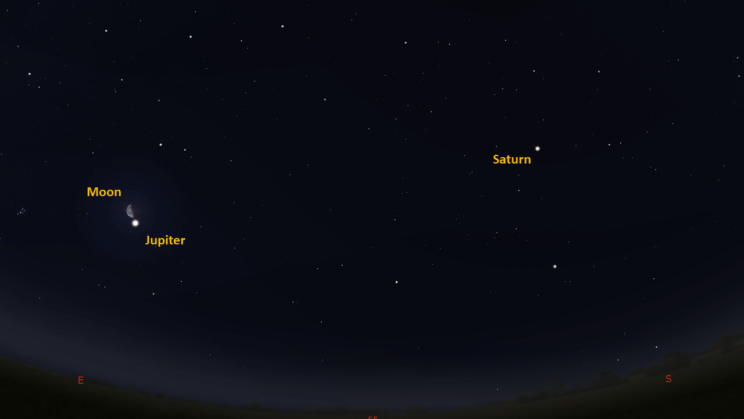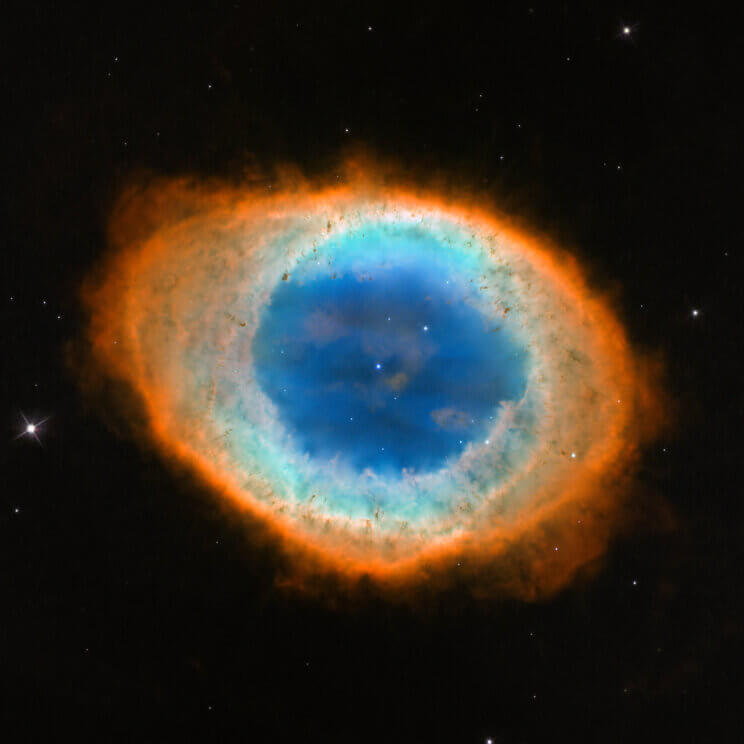This is the Saint Louis Science Center’s NIGHT SKY UPDATE for the week of Saturday, August 5, 2023.
Information updated weekly or as needed.
Times given as local St. Louis time which is Central Daylight Time (CDT). For definitions of terminology used in the night sky update, click the highlighted text. If relying on times posted in Universal Time (UT), St. louis is -5 hours when CDT.
Public Telescope Viewings
As part of the Saint Louis Science Center’s First Fridays, weather permitting, the St. Louis Astronomical Society and the Science Center will set up a number of telescopes outdoors and be on-hand to answer your questions. Telescope viewing begins once it is dark. Regardless of the weather on September 1 , join us indoors in our planetarium theater for “The Sky Tonight”. Showtime is at 7 p.m. There is no First Friday event in July.
Observing Highlight of the Week
The Ring Nebula (M57) as seen by the Hubble Space Telescope. M57 is a planetary nebula located about 2000 light years away in the constellation Lyra. The colors of light seen in the nebula are produced as energy radiated by a dying star excites gasses cast-off by the star. The different colors are caused by different gasses being ionized. Image credit: NASA, ESA and the Hubble Heritage (STScI/AURA)-ESA/Hubble Collaboration
This week we will highlight the summer constellation Lyra the Harp. For a smaller constellation, Lyra contains several interesting targets to track down. Several stars, a planetary nebula and an open cluster will keep an observer busy.
Lyra is associated with the Greek story of Orpheus. The story states that Orpheus’s wife Eurydice was killed by a viper and became lost in the underworld. Orpheus descended into the underworld with his lyre that was a gift from his father Apollo. Using this lyre, Orpheus played music that was so moving it charmed the king of the underworld, Hydes, into allowing Eurydice to follow Orpheus home. The one catch was Orpheus could not turn back and look at Eurydice until they were out of the underworld. Unfortunately, at the last moment, Orpheus was unable to fight the urge and he looked back at Eurydice, and she was lost forever.
Lyra is easy to find as its brightest star Vega is one of the stars in the Summer Triangle. You can find the Summer Triangle high in the eastern sky about 45 minutes after sunset. The Summer Triangle is made up of Vega, Altair and Deneb; Vega is the one in the top right corner of the triangle. Once you have found Vega the remaining bright stars in Lyra form a parallelogram shape south of Vega. These are the stars Zeta, Delta, Beta and Gamma Lyrae.
Delta Lyrae makes for an interesting binocular target. Sighting in on this star you will easily see two stars. While the pair appear to be a double star, they are only a line-of-sight double. While not gravitationally bound, Delta Lyrae 1 and 2 are interesting because they have drastically different colors. Delta 1 is a hydrogen fusing blue dwarf star while Delta 2 is a red giant star. The contrast is quite striking when viewed through binoculars. Delta Lyrae also appears to be part of an open star cluster but there is still some debate on this matter. This cluster is named the Delta Lyrae Cluster. It also appears that the Delta Lyrae cluster is part of an OB association that spans across parts of Cygnus and Lyra.
Beta Lyrae is another star of Interest in Lyra. Beta Lyrae is an eclipsing binary system. Eclipsing binaries are a type of variable star that fluctuates in magnitude due to multiple stars orbiting one another. From Earth we view the pair of stars along the plane of their orbit which allows the members to eclipse one another. The primary eclipse of the Beta Lyrae system occurs over a period of roughly 12.9 days. The variance in brightness ranges from 3.2 at brightest to 4.4 at its dimmest. This variance will be observable to the naked eye and your best bet to notice it is to compare its brightness to surrounding stars.
One of the best targets in Lyra is the planetary nebula Messier 57 (M57) or what is commonly called the Ring Nebula. Planetary nebulae are regions of dust and gas that formed from the cast-off layers of a dying intermediate mass star. What remains of the star is a dense compact core called a white dwarf. Radiated energy from this object ionizes the gases shed off from the star causing the gas to emit light. New research has suggested that the Sun might produce a planetary nebula in roughly 5 billion years as it evolves from its red giant phase into a white dwarf. While not all scientists agree on this, it is an interesting change in the conversation regarding how the Sun will meet its end.
To find M57 first look for the bright star Vega. South of this is the asterism called the Parallelogram of Lyra. This asterism is made up of the stars Zeta, Delta, Beta and Gamma Lyrae. Once you can identify these four stars, point a telescope between the stars Beta and Gamma Lyrae. About halfway between them, you will find a ghostly donut shaped patch of light; this is M57. Telescopes are needed to spot M57, but they do not need to be large.
The constellation Lyra is another great summertime constellation. While it is best seen in the summer, you will continue to see it well into January.
The Sun and Moon

The Moon as seen from the International Space Station, on July 31, 2011.
Credit: NASA
Sun
Sunrise is at 6:06 a.m. on Saturday, August 5 and sunset is at 8:07 p.m. providing us with roughly 14 hours of daylight. Even after sunset, light from the Sun will dimly illuminate our sky for about 1 hour and 40 minutes. This period is called twilight, which ends around 9:51 p.m. this week. For those with a sundial, local noon occurs around 1:06 p.m. this week.
| Day | Sunrise | Sunset | ||||||||||
|---|---|---|---|---|---|---|---|---|---|---|---|---|
| 5-Aug | 6:06 a.m. | 8:07 p.m. | ||||||||||
| 6-Aug | 6:07 a.m. | 8:06 p.m. | ||||||||||
| 7-Aug | 6:07 a.m. | 8:05 p.m. | ||||||||||
| 8-Aug | 6:08 a.m. | 8:04 p.m. | ||||||||||
| 9-Aug | 6:09 a.m. | 8:03 p.m. | ||||||||||
| 10-Aug | 6:10 a.m. | 8:01 p.m. | ||||||||||
| 11-Aug | 6:11 a.m. | 8:00 p.m. | ||||||||||
| 12-Aug | 6:12 a.m. | 7:59 p.m. | ||||||||||
| 13-Aug | 6:13 a.m. | 7:58 p.m. |
Moon
Moonrise for Saturday, August 5 was at 10:45 p.m. and moonset occurs at 11:50 a.m. on the following day. On Saturday, August 5, the Moon will exhibit a waxing gibbous phase with 76% disk illumination. Last quarter moon occurs on August 8, 2023, at 5:29 p.m.
International Space Station (ISS) Observing

There are no visible passes of ISS from St. Louis for the week of August 5. ISS will return to St. Louis skies on August 19 when returns to early morning passes. Besides ISS, there are numerous other satellites to track down. Visit heavens-above.com to learn more about these passes.
Magnitude (Mag): The Measure of brightness for a celestial object. The lower the value is, the brighter the object will be.
Altitude (Alt): The angle of a celestial object measured upwards from the observer’s horizon.
Azimuth (Az): The direction of a celestial object, measured clockwise from an observer’s location with north being 0°, east being 90°, south being 180° and west being 270°.
For information about ISS flyovers and other visible satellites, visit www.heavens-above.com
Detailed information regarding all unmanned exploration of our universe, missions past, present, and planned, can be found at Jet Propulsion Laboratories:
The Visible Planets

Looking Southeast at 2:00 a.m. on August 8, 2023. Credit: Stellarium, EG
This week, three naked eye planets will be visible. Mars is still visible in the west about 30 minutes after sunset. It will be low so twilight will make spotting Mars challenging. Saturn and Jupiter will be easy to find but you will have to go out in the late evening and morning hours. Saturn will be in the southeast around 11:00 p.m., while Jupiter will be east in the early morning.
Mars
Mars now rises before sunset, becoming visible once it is dark. Look for it in the west about 30 minutes after sunset. Mars sets at 9:29 p.m.
Jupiter
Jupiter rises at 11:54 p.m. About one hour after Jupiter rises, it should be easy to spot. Jupiter will rise about 20 minutes earlier each week.
Saturn
Saturn rises at 9:02 p.m. Start looking for Saturn about 30 minutes after it rises. If you have lots of trees or buildings, you may have to wait an hour or so after it rises before it will be visible. Saturn reaches opposition on August 27, 2023.
James S. McDonnell Planetarium
Night Sky Update: August 5-13, 2023







